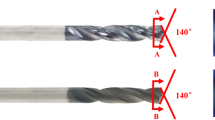Abstract
Mechanical drilling of composite/metal stacks is a challenging task due to the rapid tool wear leading to poor hole quality and short tool life. To control effectively the wear process of tools, a scientific understanding of phenomena behind the drill wear progression remains a subject of fundamental importance. The present work aims to quantify the mechanisms of the drill edge wear during the machining of CFRP/Ti6Al4V stacks using diamond-coated twist drills. The novelty of this study lies in identifying the phenomenon of the wear mode transition during the stacks machining. A quantitative analysis was conducted to correlate the flank wear extents at different positions of drill edges with the material removal volume at the constant cutting speed and feed rate. The wear rate of each drill edge segment was studied with respect to the material removal volume. A mechanism transition from adhesion to abrasion is identified after drilling a certain number of stack holes, being the cause of the phenomenon that the drill wear rate decreases with increasing the material removal volume. The results discussed in this paper offer several implications for the structure design and edge reinforcement of drill bits specialized for the machining of CFRP/Ti6Al4V stacks.












Similar content being viewed by others
References
Pramanik A, Littlefair G (2014) Developments in machining of stacked materials made of CFRP and titanium/aluminum alloys. Mach Sci Technol 18(4):485–508
Kim D, Beal A, Kwon P (2016) Effect of tool wear on hole quality in drilling of carbon fiber reinforced plastic–titanium alloy stacks using tungsten carbide and polycrystalline diamond tools. J Manuf Sci Eng-Trans ASME 138(3):031006
Xu J, El Mansori M (2016) Numerical studies of frictional responses when cutting hybrid CFRP/Ti composite. Int J Adv Manuf Technol 87(1–4):657–675
Xu J, Mkaddem A, El Mansori M (2016) Recent advances in drilling hybrid FRP/Ti composite: a state-of-the-art review. Compos Struct 135:316–338
Xu J, El Mansori M (2016) Experimental study on drilling mechanisms and strategies of hybrid CFRP/Ti stacks. Compos Struct 157:461–482
Alonso U, Calamaz M, Girot F, Iriondo E (2019) Influence of flute number and stepped bit geometry when drilling CFRP/Ti6Al4V stacks. J Manuf Process 39:356–370
Impero F, Dix M, Squillace A, Prisco U, Palumbo B, Tagliaferri F (2018) A comparison between wet and cryogenic drilling of CFRP/Ti stacks. Mater Manuf Process 33(12):1354–1360
Xu J, Zhou L, Chen M, Ren F (2019) Experimental study on mechanical drilling of carbon/epoxy composite-Ti6Al4V stacks. Mater Manuf Process 34(7):715–725
Xu J, Li C, Chen M, Ren F (2019) A comparison between vibration assisted and conventional drilling of CFRP/Ti6Al4V stacks. Mater Manuf Process 34(10):1182–1193
Xu J, Ji M, Chen M, Ren F (2019) Investigation of minimum quantity lubrication effects in drilling CFRP/Ti6Al4V stacks. Mater Manuf Process 34(12):1401–1410
Xu J, El Mansori M, Chen M, Ren F (2019) Orthogonal cutting mechanisms of CFRP/Ti6Al4V stacks. Int J Adv Manuf Technol 103(9–12):3831–3851
Xu J, El Mansori M, Voisin J, Chen M, Ren F (2019) On the interpretation of drilling CFRP/Ti6Al4V stacks using the orthogonal cutting method: chip removal mode and subsurface damage formation. J Manuf Process 44:435–447
Park KH, Beal A, Kim D, Kwon P, Lantrip J (2014) A comparative study of carbide tools in drilling of CFRP and CFRP-Ti stacks. J Manuf Sci Eng-Trans ASME 136(1):014501
Senthilkumar M, Prabukarthi A, Krishnaraj V (2018) Machining of CFRP/Ti6Al4V stacks under minimal quantity lubricating condition. J Mech Sci Technol 32(8):3787–3796
Park KH, Beal A, Kim D, Kwon P, Lantrip J (2011) Tool wear in drilling of composite/titanium stacks using carbide and polycrystalline diamond tools. Wear 271(11–12):2826–2835
Wang X, Kwon PY, Sturtevant C, Kim D, Lantrip J (2014) Comparative tool wear study based on drilling experiments on CFRP/Ti stack and its individual layers. Wear 317(1–2):265–276
Ghassemieh E (2012) Performance and wear of coated carbide drill in machining of carbon fibre reinforced composite/titanium stack. Int J Mater Prod Technol 43(1–4):165–183
Isbilir O, Ghassemieh E (2013) Comparative study of tool life and hole quality in drilling of CFRP/titanium stack using coated carbide drill. Mach Sci Technol 17(3):380–409
Rawat S, Attia H (2009) Wear mechanisms and tool life management of WC-Co drills during dry high speed drilling of woven carbon fibre composites. Wear 267(5–8):1022–1030
Davim JP (2009) Machining composite materials. Wiley-ISTE, UK
Çelik A, Lazoglu I, Kara A, Kara F (2015) Wear on SiAlON ceramic tools in drilling of aerospace grade CFRP composites. Wear 338:11–21
Muhamad Khairussaleh NK, Che Haron CH, Ghani AJ (2016) Study on wear mechanism of solid carbide cutting tool in milling CFRP. J Mater Res 31(13):1893–1899
Zhang PF, Churi NJ, Pei ZJ, Treadwell C (2008) Mechanical drilling processes for titanium alloys: a literature review. Mach Sci Technol 12(4):417–444
Batista Ponce M, Vazquez-Martinez JM, Davim JP, Salguero Gomez J (2019) Analysis of secondary adhesion wear mechanism on hard machining of titanium aerospace alloy. Materials 12(12):2015
Ayed Y, Germain G, Melsio AP, Kowalewski P, Locufier D (2017) Impact of supply conditions of liquid nitrogen on tool wear and surface integrity when machining the Ti-6Al-4V titanium alloy. Int J Adv Manuf Technol 93(1–4):1199–1206
Sun FJ, Qu SG, Deng ZH, Su F, Li XQ (2017) Shear band formation and wear mechanism of titanium alloy powder metallurgy material prepared by HIP using Ti-6Al-4V pre-alloy powder. Int J Adv Manuf Technol 93(9–12):4439–4445
Xu J, El Mansori M (2016) Experimental studies on the cutting characteristics of hybrid CFRP/Ti stacks. Procedia Manuf 5:270–281
Xu J, El Mansori M (2017) Wear characteristics of polycrystalline diamond tools in orthogonal cutting of CFRP/Ti stacks. Wear 376-377:91–106
Funding
This work was supported by the National Natural Science Foundation of China (Grant No. 51705319).
Author information
Authors and Affiliations
Corresponding author
Additional information
Publisher’s note
Springer Nature remains neutral with regard to jurisdictional claims in published maps and institutional affiliations.
Rights and permissions
About this article
Cite this article
Xu, J., Ji, M. & Chen, M. On the quantitative analysis of drill edge wear when machining CFRP/Ti6Al4V stacks. Int J Adv Manuf Technol 108, 1463–1472 (2020). https://doi.org/10.1007/s00170-020-05206-z
Received:
Accepted:
Published:
Issue Date:
DOI: https://doi.org/10.1007/s00170-020-05206-z



